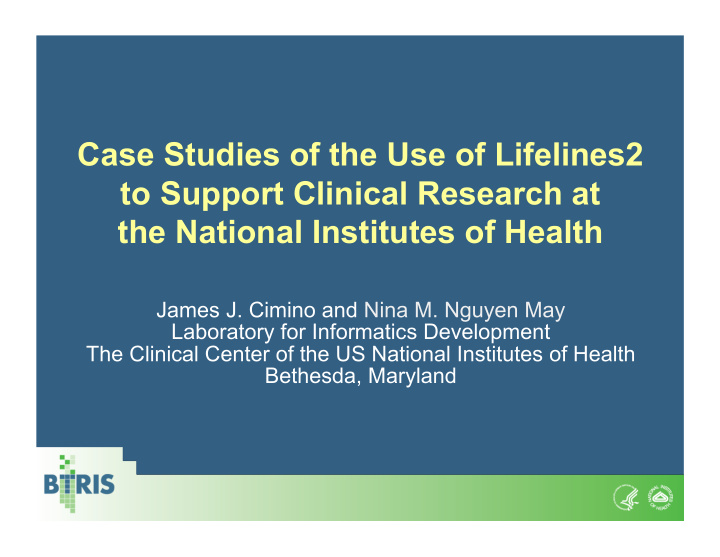



Case Studies of the Use of Lifelines2 to Support Clinical Research at the National Institutes of Health James J. Cimino and Nina M. Nguyen May Laboratory for Informatics Development The Clinical Center of the US National Institutes of Health Bethesda, Maryland
The US National Institutes of Health (NIH) • 27 institutes and centers • Main campus is north of Washington, DC • Clinical Center is the research hospital of NIH – 240 in-patient beds – Out-patient clinics – Commercial electronic health record (EHR)
Clinical Data at NIH Institute System Personal “System” EHR Lab System
Clinical Data at NIH Institute System Personal “System” EHR Lab System BTRIS
N NIAAA I N NIAID 33 33 R NICHD Other CC Sources Radiology Images CRIS, MIS NINDS NCI NHL BI NID DK NHGRI
Data Domains • MIS • CRIS – Blood Bank – Alerts – Demographics – Allergies – Lab Tests and Panels – Anatomic Pathology – Microbiology – Blood Bank – Radiology Reports – Clinical Documents – Vital Signs – Demographics – Diagnoses/Problems – Echocardiograms – Electrocardiograms • Other institutes – Lab Tests and Panels – NIAID (CRIMSON): Labs, Meds) – Medication Administration – Medication Orders – NIAAA (Clinical Assessments) – Microbiology – NCI (Labmatrix, C3D) – Radiology Reports – NICHD (CTDB: Forms) – Radiology Images – Vital Signs – NHGRI (Labmatrix)
BTRIS Data Growth
Case Studies • BTRIS users asked about interest in visualization • Summer student worked with researchers to identify problems of interest • Data selected from BTRIS • Modeled as events (“binning”) • Heterogeneous data sets merged into single files
Hypoparathyroidism • Parathyroid glands produce insufficient hormone • Inadequate calcium absorption • Low serum calcium; elevated serum phosphate • Treatment may decrease renal function • Creatinine clearance drops, serum creatinine rises • Elevated calcium excretion leads to nephrocalcinosis • Data set: 86 patients; 37,347 events • Five laboratory measures (green), three radiology results (blue), and two medications (pink) • One patient with progressive nephrocalcinosis (red)
PROGRESSIVE NEPHROCALCINOSIS
Prostate Cancer • Prostate produces prostate-specific antigen (PSA) • PSA levels rise in prostate disease (infection, age- related hypertrophy, cancer) • Velocity of change correlates with rate of growth • Data set: 30 patients; 676 events • Set 1: PSA levels increased >250% from baseline • Set 2: PSA levels decreased and remained low
Cushing Disease • Increased adrenal corticotropic hormone secretion from pituitary tumor • Increased cortisol production by adrenal gland • Tumor removed by transsphenoidal adenomectomy • Data set: 103 patients; 4,355 events • Normalized to time of surgery (blue) • Elevated cortisol (24H-UFC) levels initially • All cortisol levels normalized • Other abnormal tests (cholesterol, triglycerides, insulin, glucose) returned to normal
Chronic Granulomatous Disease • Inherited immune disorder • Phagocytes don’t kill certain types of bacteria and fungi • Patients suffer from chronic and recurrent infections • Amphotericin B is treatment for fungus but toxic to kidneys • Data set: 157 patients; 37,454 values • Normalization of renal function after Amphotericin B • High serum creatinine (dark blue); normal serum creatinine (light blue)
Discussion • Discrete event data not easy to analyze in tabular form • Fuzzy time periods due to inconsistent collection • Temporal visualization well-suited for event data • Heterogeneous data merged through creative binning • “Sorting trick” makes ordinal events semi-quantitative • Collaborators uniformly grateful for analyses and seeking further collaboration
Acknowledgments • Clinical collaborators: Dr. Betty Marciano, Dr. Karen Winer, Dr. Jenn Marte, Dr. Maya Lodish • BTRIS team for technical support • Human-Computer Interaction Lab (HCIL) at the University of Maryland • This research was supported in part by intramural research funds from the NIH Clinical Center
http://btris.nih.gov btris.nih.gov
Recommend
More recommend